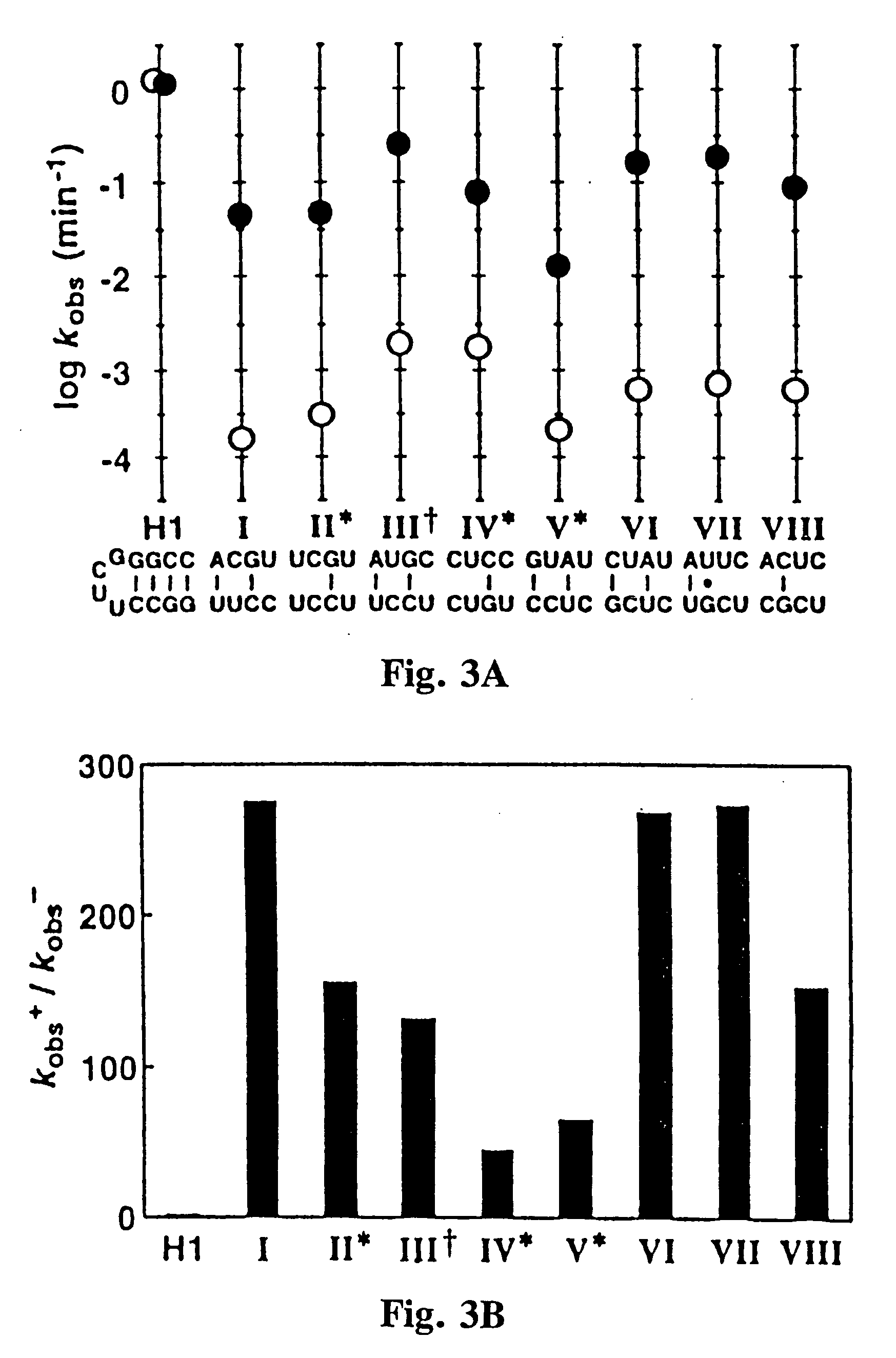Multidomain polynucleotide molecular sensors
a multi-domain, molecular sensor technology, applied in the field of allosteric polynucleotides, can solve the problems of limiting the versatility of allosteric ribozyme engineering, affecting the development of allosteric ribozyme controlled by effectors, and preventing the exclusive use of modular rational design to achieve the effect of wide application and level of catalytic performan
- Summary
- Abstract
- Description
- Claims
- Application Information
AI Technical Summary
Benefits of technology
Problems solved by technology
Method used
Image
Examples
example 1
Engineering Precision RNA Molecular Sensors
[0060] Ligand-specific molecular sensors composed of RNA were created by coupling pre-existing catalytic and receptor domains via novel structural bridges (65). Binding of ligand to the receptor triggers a conformational change within the bridge, and this structural reorganization dictates the activity of the adjoining ribozyme. The modular nature of these tripartite constructs makes possible the rapid construction of precision RNA molecular sensors that trigger only in the presence of their corresponding ligand.
Materials and Methods
[0061] Oligonucleotides. Synthetic DNA and the 14-nucleotide substrate RNA were prepared by standard solid phase methods and purified by denaturing (8 M urea) polyacrylamide gel electrophoresis (PAGE) as described previously (4). RNA substrate was 5′-32P-labeled with T4 polynucleotide kinase and (γ-32P)-ATP, and repurified by PAGE. Double-stranded DNA templates for in vitro transcription using T7 RNA polymer...
example 2
In Vitro Selection of Theophylline-Sensitive Allosteric Hammerhead Ribozymes
[0078] To investigate whether the process of developing communication modules may be applicable toward any number of aptamer-ribozyme combinations, in vitro selection for allosteric hammerhead ribozymes activated by theophylline binding has been performed. This selection has sought not only to validate the combined modular rational design and in vitro selection process, but develop new communication modules that try the limits of nucleic acid allostery. The initial population for the development of allosteric theophylline-sensitive ribozymes is conceptually identical to that previously demonstrated to yield FMN-sensitive catalysts. However, the theophylline aptamer was appended to stem II of the hammerhead ribozyme through a random-sequence region consisting of 5+5 or 10 total nucleotide positions (FIG. 7A). An RNA population resulting from eight rounds of in vitro selection and amplification of theophylli...
example 3
Allosteric Selection of Ribozymes Responsive to cGMP and cAMP Messengers
[0079] Example 1 illustrated the generation of a series of allosteric ribozymes using a three-domain construct (FIGS. 1 and 8). For several of the bridging domains identified, it was observed during the course of experiments that replacing the original aptamer domain with different aptamer domains having various ligand specificities produced new allosteric ribozymes with the corresponding effector dependencies. In other words, certain bridging domains or communication modules including the class I communication module (cm+FMN1) depicted in FIG. 8 appear to serve as generic reporters of the occupation state of different appended aptamers regardless of the particular ligand specificity. This example reports further studies conducted to investigate whether undiscovered aptamers could trigger ribozyme function if they were judiciously integrated into the effector-binding site of the tripartite RNA construct. A new...
PUM
| Property | Measurement | Unit |
|---|---|---|
| pH | aaaaa | aaaaa |
| catalytic activity | aaaaa | aaaaa |
| concentration | aaaaa | aaaaa |
Abstract
Description
Claims
Application Information
 Login to View More
Login to View More - R&D
- Intellectual Property
- Life Sciences
- Materials
- Tech Scout
- Unparalleled Data Quality
- Higher Quality Content
- 60% Fewer Hallucinations
Browse by: Latest US Patents, China's latest patents, Technical Efficacy Thesaurus, Application Domain, Technology Topic, Popular Technical Reports.
© 2025 PatSnap. All rights reserved.Legal|Privacy policy|Modern Slavery Act Transparency Statement|Sitemap|About US| Contact US: help@patsnap.com



